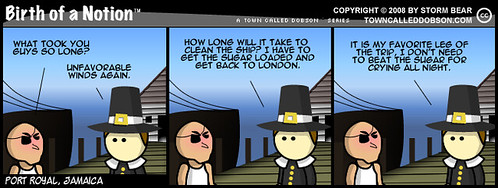 click to enlarge The most famous triangular trade in human history was the 18th century trade between West Africa, the West Indies, and Europe (alternatively: West Africa, the West Indies, and northern colonies in British North America). Of these, the sea lane west from Africa was the notorious Middle Passage; its cargo, abducted or recently purchased African slaves. The trade represented a profitable enterprise for merchants. The business was risky, competitive, and severe, but enslaved Africans fetched a high price at auctions, making the trade in human cargo a lucrative business. European colonists initially practiced systems of both bonded labor and Indian slavery, enslaving many of the natives of the New World. For a variety of reasons, Africans replaced Indians as the main population of slaves in the Americas. In some cases, such as on some of the Caribbean Islands, disease such as smallpox and warfare eliminated the natives completely. In other cases, such as in South Carolina, Virginia, and New England, the need for alliances with native tribes coupled with the availability of African slaves at affordable prices (beginning in the early 18th century for these colonies) resulted in a shift away from Indian slavery. It is often falsely claimed that Indians made poor slaves compared to Africans, explaining the shift to using Africans. The reasons had more to do with economics and politics. The first leg of the triangle was from a European port, where supplies such as copper, cloth, trinkets, slave beads, guns and ammunition would be shipped to a port in Africa. When the slave ship arrived, its cargo would be sold in exchange for slaves, who were often tightly-packed like any other cargo to maximize profits. The ship would then make the journey along the Middle Passage to the New World. Once the slave ship reached the New World, the survivors would be sold for a good profit. The ships were then prepared to get them thoroughly cleaned, drained, and loaded for a return voyage to their home port. A burial ground in Campeche, Mexico, suggests slaves had been brought there not long after Hernán Cortés completed the subjugation of Aztec and Mayan Mexico. The graveyard had been in use from about 1550 to the late 1600s. The first side of the triangle was the export of goods from Europe to Africa. A number of African kings and merchants took part in the trading of slaves from 1440 to about 1900. For each captive, the African rulers would receive a variety of goods from Europe. Many of them were confronted with the dilemma of trading with Europe or becoming slaves themselves. The second leg of the triangle exported enslaved Africans across the Atlantic Ocean to South America, the Caribbean islands, and North America. The third and final part of the triangle was the return of goods to Europe from the Americas. The goods were the products of slave-labor plantations and included cotton, sugar, tobacco, molasses and rum. From the West Indies the main cargo was sugar, rum, and molasses; from Virginia, it was tobacco and hemp. The ship then returned to Europe to complete the triangle. Alternatively, New England also benefited from the trade, as many merchants were from New England, especially Rhode Island, replacing the role of Europe in the triangle. New England also made rum from the Caribbean sugar and molasses, which it shipped to Africa as well as within the New World. However, Brazil (the main importer of slaves) manufactured these goods in South America and directly traded with African ports, thus not taking part in a triangular trade. Disclaimer:
|
Friday, March 28, 2008
Black History: Triangular Trade
Posted by
Storm Bear
at
7:44 AM
![]()
Labels: Africa, cartoons, comics, middle passage, slavery, triangular trade, webcomics
Subscribe to:
Post Comments (Atom)








0 comments:
Post a Comment